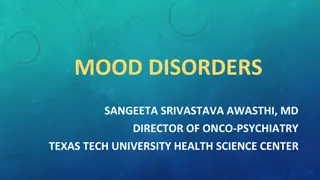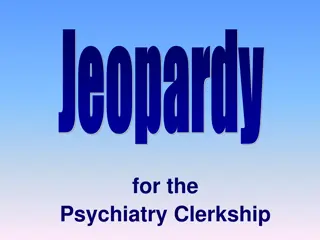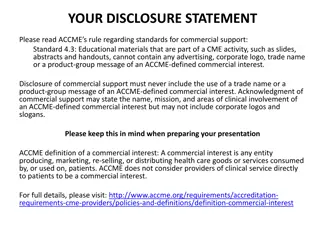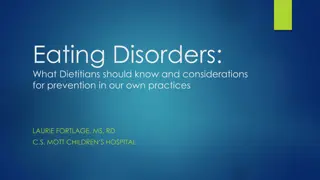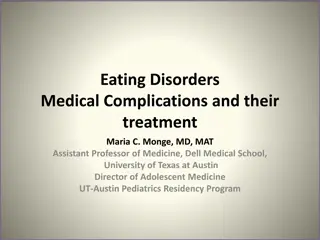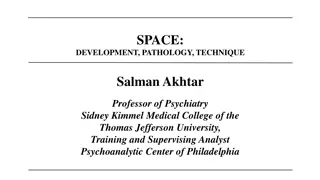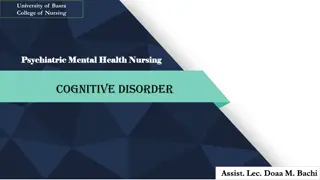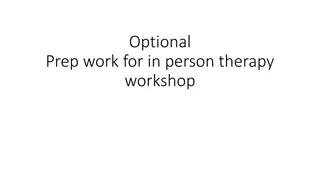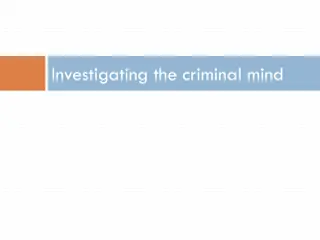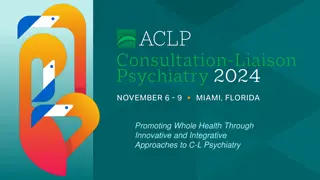Understanding Thought Disorders in Psychiatry: Insights from Clinical Meeting Presentation
Explore the definitions and divisions of thought disturbances in psychiatry, including disorders of thought stream, form, content, and possession. Delve into thought stream disorders like tempo and continuity disruptions, as well as form of thinking disorders seen in conditions like schizophrenia. Gain valuable insights from Dr. Uhunmwuagho I. Faith's presentation at the Federal Neuropsychiatric Hospital, Uselu.
Download Presentation

Please find below an Image/Link to download the presentation.
The content on the website is provided AS IS for your information and personal use only. It may not be sold, licensed, or shared on other websites without obtaining consent from the author. Download presentation by click this link. If you encounter any issues during the download, it is possible that the publisher has removed the file from their server.
E N D
Presentation Transcript
SIGNS AND SYMPTOMS IN PSYCHIATRY: DISORDERS OF THOUGHT PRESENTED AT CLINICAL MEETING OF FEDERAL NEUROPSYCHIATRIC HOSPITAL, USELU ON THIS DAY 20TH JULY,2022 BY DR UHUNMWUAGHO I. FAITH 1
OUTLINE DEFINITION OF THOUGHT DISTURBANCES OF THOUGHT STREAM DISTURBANCES OF THOUGHT FORM DISTURBANCES OF THOUGHT CONTENT DISTURBANCES OF THOUGHT POSSESSION MANAGEMENT CONCLUSION REFERENCES 2
Objectives To discuss concept of thought and the disorder associated with thought 3
DEFINITION OF THOUGHT Thought (or thinking) is process in which ideas, memories, imagination, pictures are manipulated through formation of concepts to solve problems. Speech is the expression of thoughts in the form of sounds produced by the mouth and associated organs. Thought can be assessed through speech. 4
DIVISION OF DISTURBANCES OF THOUGHT Disorders of thought include; -Stream of thought -Form of thinking -Thought content -Possession of thought 5
THOUGHT STREAM DISORDER Further divided into- disorders of thought tempo Pressure of thought and poverty of thought disorders of the continuity\connectivity of thinking thought blocking 6
THOUGHT STREAM DISORDER Disorder of thought tempo -Pressure of thought; ideas arise in unusual variety and abundance and pass through the mind rapidly. Found in mania. -Poverty of thought; the patient has few thoughts, and these lack variety and richness and seem to move slowly through the mind, found in depression. Disorders of the continuity -Thought block; Sometimes the stream of thought is interrupted suddenly. The patient feels that his mind has gone blank, and an observer notices a sudden interruption in the patient s speech. Found in schizophrenia. 7
FORM OF THINKING DISORDERS Form of thinking disorder is a disorder of abstract thinking commonly seen in schizophrenia. Features of healthy thinking includes, constancy, organization, continuity. Form of thinking disorders Includes, Loosening of association -Verbigeration/word salad -Knight s move/Derailment -Tangentiality Flight of ideas -Rhyming\clanging -punning Neologisms 8
Loosening of association; This denotes a loss of the normal structure of thinking. To the interviewer the patient s discourse seems muddled, irrelevant, or illogical to the matter in hand. Seen in schizophrenia. - Verbigeration; this is said to be present when speech is reduced to the senseless repetition of sounds, words, or phrases - Tangentiality; the patient departs from topic of discussion with no return. 9
. -Knight s move or derailment; this refers to a transition from one topic to another, either between sentences or in mid- sentence, with no logical relationship between the two topics and no evidence of the associations. There is extreme irrelevance. Neologisms are word or phrases invented by the patient, often to describe a morbid experience. 10
Flight of ideas- thoughts and speech move quickly from one topic to another so that one train of thought is not carried to completion before another takes its place. Disorder can be found in mania. -rhyming/clanging- rhyming of words. -punning - talking in riddles. Others- Circumstantiality occurs when thinking proceeds slowly with many unnecessary details, but finally, the point is reached. Can be found in patients with learning disabilities. 11
. Perseveration is the persistent and inappropriate repetition of the same thoughts. The disorder is detected by examining the person s words or actions. Thus, in response to a series of simple questions, the person may give the correct answer to the first question, but continue to give the same answer inappropriately to subsequent questions. Perseveration is common in generalized and local organic disorders of the brain. 12
DISTURBANCES OF THOUGHT CONTENT Include: -Preoccupation -Phobia -Ideation - Overvalued ideas -Obsessions -Delusions 13
. Preoccupation- centering thought to a particular idea in association with strong affection. Phobia Overwhelming fear of an object, place, situation, feeling or animal. Types includes; -Agoraphobia- fear of open spaces. -Social phobia- fear of being judged by other people. -Specific phobia- fear of objects , animals or habits. Ideation- could be suicidal ideation, or homicidal ideation. 14
. Overvalued idea An overvalued idea is a comprehensible and understandable idea which is pursued beyond the bounds of reason. It may preoccupy and dominate a person s life for many years, and affect their actions. 15
. Obsessions Obsessions are recurrent persistent thoughts, impulses, or images that enter the mind despite efforts to exclude them Types of obsessions include: Obsessional thoughts which are repeated and intrusive words or phrases that are upsetting to the patient Obsessional ruminations are repeated worrying themes of a more complex kind for example, about the ending of the world Obsessional doubts are repeated themes expressing uncertainty about previous actions for example, whether or not the person locked his door before leaving home
. Obsessional impulses are repeated urges to carry out actions, usually ones that are aggressive, dangerous, or socially embarrassing. Obsessional phobias. This term denotes an obsessional symptom associated with avoidance as well as anxiety for example, the obsessional impulse to injure another person with a knife may lead to consequent avoidance of knives. People with obsessional slowness perform actions slowly because their compulsive rituals or repeated doubts take time and distract them from their main purpose.
Delusions A delusion is a belief that is firmly held on inadequate grounds, that is not affected by rational argument or evidence to the contrary, and that is not a conventional belief that the person might be expected to hold given their educational, cultural, and religious background. 18
. Delusions can be divided into: According to fixity -Complete delusion is a delusion that is held strongly without any degree of doubt. -Partial delusion is a delusion that is held with a degree of doubt. According to onset -Primary delusion is one that appears suddenly and with full conviction but without any mental events leading up to it. -Secondary delusions are delusions apparently derived from a preceding morbid experience 19
. According to theme (content) -Persecutory (paranoid) -Delusions of reference -Delusion of control -Grandiose (expansive) -Delusions of guilt -Nihilistic -hypochondriacal -Jealousy -Sexual or amorous 20
. -Persecutory delusions, the individual believes that person(s) or organization(s) is/are trying to inflict harm on him, damage his reputation, or make him insane. -Delusion of reference is concerned with the idea that objects, events, or people that are unconnected with the patient have a personal significance for him. -A patient who has a Delusion of control believes that his actions, impulses, or thoughts are controlled by an outside agency. These are also called passivity phenomena. 21
Grandiose delusions are beliefs of exaggerated self- importance. The patient may consider himself to be wealthy, endowed with unusual abilities, or a special person. Seen in mania. Delusion of guilt are minor action of breaking the terms of the law in the past, it will be discovered and bring shame upon the patient, or that his sinfulness will lead to retribution on his family. Seen in depression 22
Nihilistic delusions are beliefs that some person or thing has ceased, or is about to cease, to exist. Examples include a patient s delusion that he has no money, that his career is ruined, or that the world is about to end. seen in depression. In hypochondriacal delusions the patient believes, wrongly and in the face of all medical evidence to the contrary, that he is suffering from a disease. 23
In delusion of jealousy the person is preoccupied with the thought that their spouse or sexual partner is being unfaithful without having any real proof. Sexual or amorous delusions (De Clerambault syndrome)are more frequent in women than in men and are occasionally secondary to somatic hallucinations felt in the genitalia. . 24
Primary delusional experiences A delusional mood is a change of mood that accompanies a delusion. For example, a person who believes that a group of people intends to kill him is likely to feel afraid. Occasionally, the change of mood precedes the delusion. A delusional perception is a delusional interpretation to a normal perception. For example, the position of a letter that has been left on the patient s desk may be interpreted as a signal that he is to die. A delusional memory is a delusional interpretation that is attached to a past event. The past event either real, or made up by the patient 25
Specific delusional syndromes Shared delusions is a person who lives with a deluded patient comes to share his delusional beliefs. Delusional misidentification is the belief that the identity of a person, object, or place has somehow changed or has been altered. There are quite a number of syndromes under this type of delusion. For example, a person may believe that a close relative or spouse has been replaced by an identical- looking impostor(Capgras delusion), or believe that various people the person meets are actually the same person in disguise(Fregoli delusion). 26
The reality of delusion It is important to note that not all individuals with delusions act on their delusional beliefs. Usually, when a delusional illness becomes chronic there is a difference between the delusions and the patient s behavior. For example, the persecuted patient who believes they are being poisoned may be happy to eat hospital food. 27
DISTURBANCE OF THOUGHT POSSESSION Thought insertion is a belief that someone is putting ideas or thoughts into their minds. Thought withdrawal is a delusion that thoughts have been taken out of the mind by someone/something. Thought broadcasting is a delusion that unspoken thoughts, are known to other people through radio, telepathy, or in some other way. Though echo is a belief that the person hears his or her own thoughts as if they were being spoken aloud. 28
MANAGEMENT OF THOUGHT DISORDERS Management involves Good history taking Mental state examination Physical examinations Investigation Making appropriate diagnosis. In summary, management depends on the patient presentation. 29
Conclusion In conclusion, although thought disorder is associated with psychosis, similar phenomena can appear in different disorders, potentially leading to misdiagnosis. Hence it is important to properly interact with the patient and take relevant history. 30
REFERENCES Paul .H et al(2018),Shorter Oxford textbook of psychiatry 7th Edition Patricia C et al, Fish Clinical psychopathology, signs and symptoms in psychiatry 3rd Edition Kaplan and Sadock s Comprehensive Textbook of psychiatry (2017),appendix B: Glossary of psychiatry and psychology Terms Clinical manifestation of Psychiatric Disorder (2017), Thinking Disturbances, Thought content, Disturbances in Thought contents. Costa e Silva JA, thought disorder in psychiatry. 2006;55:S40-S44. 31





